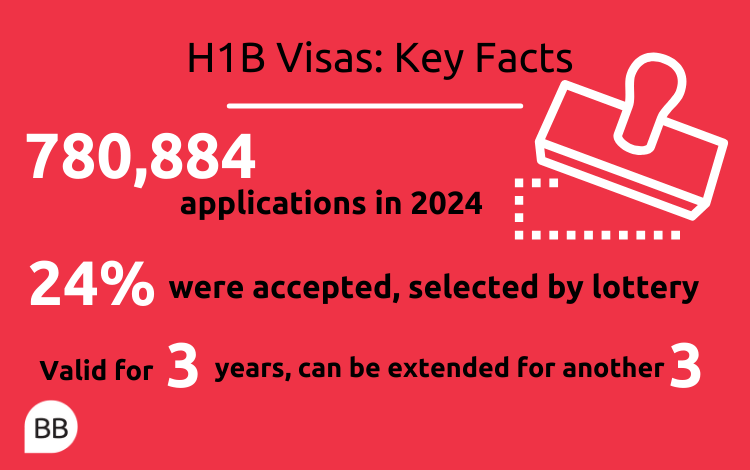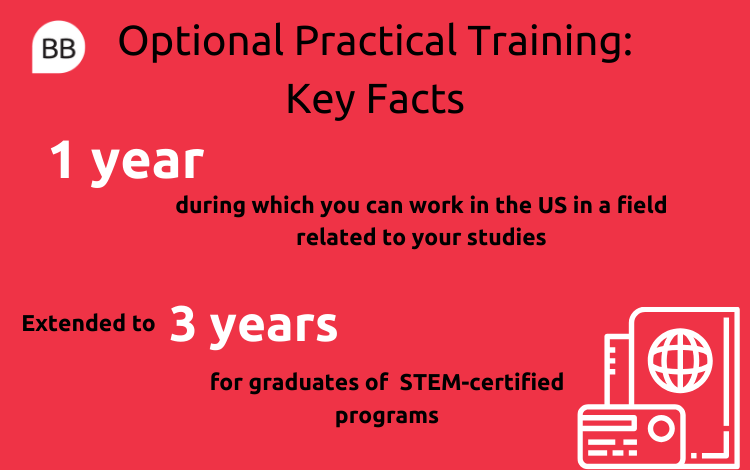The H-1B visa is a United States work visa open to speciality workers. It allows foreign nationals with specialized professional expertise, either gained through a degree or work experience, to live and work in the United States.
The USA is the most popular country for business school candidates globally, home to Harvard, Stanford, Wharton, and many of the world’s top-ranked business schools.
For international MBA and business master’s students looking to stay and work in the US long-term after graduation, an H-1B visa is a must.
So, what is an H-1B visa exactly? What’s the H-1B visa process? And what are the H-1B visa requirements?
How long is an H1B visa valid for?
The H-1B visa is a non-immigrant permit, which means it grants people entry to the US on a temporary basis. H-1B visa holders can live and work in the United States for three years, after which they can extend their stay for another three years if they wish to remain in the US. So, that’s a total of six years that you can stay in the US with an H-1B visa.
At the expiration of the maximum period of stay, you must either leave the US or obtain a different status, such as an F-1 student, an O-1 'extraordinary ability' worker, or a Green Card (see below).
To extend an H-1B visa after three years to achieve the maximum period, you’ll need a petitioner to file a Form I-126 on your behalf. Your petitioner would be your current employer or a new employer.
Who is eligible for an H1B visa?
H-1B visas are allocated through a lottery system to highly skilled foreign nationals. To meet the H-1B visa requirements, you need at least a bachelor’s degree and you need to be working in one of a number of specialty professions, which include business and management roles.
Fortunately, H-1B visa rules favor MBA and business master’s graduates. Because there is a lot of demand for the H-1B visa, there is a limited number of visas that can be issued each year. In 2023, the cap was set at 65,000 visas per year.
However, if an applicant has a master’s degree from a US institution, they’re in luck: there are an extra 20,000 visas available for those who have a master’s degree or higher, making the cap for those with an advanced degree 85,000.
If the US employer sponsoring an H-1B worker is an institution of higher education, a nonprofit organization connected to an institute of higher education, or a government research organization, then the H-1B lottery cap does not apply.
Remember, it doesn’t matter if you did your bachelor’s abroad, as long as it’s equivalent to a US bachelor’s degree in your specialty occupation.
How much does an H1B visa cost?
You'll get H-1B visa sponsorship via your employer and your employer will typically cover the cost of your visa.
Currently, an H-1B visa application can cost between $4,730 and $10,400 depending on your personal situation. Fees include a $10 registration fee (now $215), a $460 filing fee, and a $500 fraud prevention and detection fee.
There’s also a $4,000 fee for companies with upwards of 50 employees with over half on H-1B or L1 status. Then there is the ACWIA (Training) Fee, which is $750 for companies with between one and 25 full-time employees and goes up to $1,500 for companies with more than 26 full-time employees.
Some organizations, such as non-profits affiliated with educational institutions, governmental research organizations, and primary/secondary educational institutions are exempt from the ACWIA fee.
Finally, the H-1B Premium Processing Fee costs $2,805, and is usually paid by the employee. By paying this optional fee, you’ll expedite the H-1B visa process, guaranteeing a 15-day processing time frame.
The price of filing an H-1B visa went up recently. The United States Citizenship and Immigration Services (USCIS) implemented its controversial increases to immigration fees that means the H-1B visa cost for an application is significantly more.
While the 2024 visa season remained at the same cost, the extra expense went into effect on April 1st. These changes have seen the H-1B visa E-registration fee rise by 2050% from $10 to $215. Also, the H-1B petition fee, which stood at $460, has risen to $780—a 70% increase.
On top of these, USCIS has also implemented the Asylum Program Fee which costs $600 for employers with 26 or more Full-Time Employees (FTEs); $300 for small employers (25 FTEs or less); and $0 for nonprofit organizations.
Many of the world’s largest companies—including the leading big tech firms—provide sponsorship for thousands of professionals looking to work in the US each year.
Read: The 6 Easiest Countries To Get A Work Visa
©william87
What is the H1B visa application process?
To obtain an H-1B visa, you need to be sponsored by an employer, who will petition the USCIS on your behalf.
Many employers—including top MBA recruiters like Amazon, Apple, and McKinsey—offer H-1B sponsorship to talented grads from overseas.
Although your employer will incur the great majority of the costs, that doesn’t mean they’ll take care of everything. You’ll need to apply for the visa at the US embassy of your home country and attend an interview where you’ll be asked extensively about your workplace and job role. If it’s your first time applying, they’ll even take your fingerprints.
The H-1B visa application timeline is as follows:
⇨ You’ll need to create a USCIS online account in February and submit your registration before the portal closes in late March.
⇨ The lottery happens in the last few days of March, and winners are contacted as soon as the lottery is over.
⇨ From the moment H-1B visa recipients are notified in early April, employers have 90 days to submit a petition.
The H-1B visa renewal process, which can be started up to six months before your visa expires, requires similar filing fees, forms, and supporting documents.
What are your chances in the H1B visa lottery?
Ultimately, your fate will be determined by a visa lottery.
As we’ve mentioned, being an MBA or master’s graduate you’re at an advantage, as there's an extra 20,000 visas available. Moreover, graduates from US business schools have access to appealing post-graduation opportunities, with top companies that will sponsor your H-1B visa headquartered in the US.
The average MBA salary in the USA is around $126,660, although grads from top program can expect to earn more. The sheer size of the US economy also creates a wealth of opportunities for the rising stars of the business world, in hubs like Silicon Valley for tech and Boston and New York for consulting and finance.
Read: The Top 15 Companies That Sponsor H1B Visas
@FinkAvenue
While your chances of getting an H-1B visa have improved significantly in recent years (particularly since Donald Trump's H-1B visa suspension was lifted in March 2021) there have been a number of recent changes to the H-1B visa process that will affect international students, a major one being that individuals’ names cannot be submitted into the H-1B visa lottery more than once to increase the chance of success.
However, despite these changes it is important to note that H-1B approvals have steadily increased in recent years, even when compared with pre-pandemic numbers. Though competition is strong: during FY 2024, H-1B applications increased by 61% to 780,884, nearly 700,000 above the 85,000-annual cap.
For graduates of a STEM-certified course, the odds of success are higher. STEM-designated MBA programs and STEM-designated masters incorporate a science, technology, engineering, or mathematics component in their curricula, some of the most popular areas for H-1B visa holders.
Crucially, STEM program graduates are granted a 24-month extension of their optional practice training (OPT) period, which gives them an additional two years to apply for an H-1B visa.
Read: The Best Business Schools In The USA | US News MBA Ranking
What is OPT?
International MBA or master’s students on an F-1 student visa are automatically eligible for optional practice training, or OPT, after graduation—a one-year period during which you can work in the US in a field related to your studies without an H-1B visa.
You can apply for OPT by requesting a recommendation from your university, up to 90 days before the end of your degree and no later than 60 days after you’ve completed it.
Although you can obtain an H-1B visa immediately after completing your degree, grads tend to go through optional practical training first. As the end of your OPT year nears, it’ll be time to apply for a H-1B visa if you still wish to continue working in the US.
While F-1 visas are normally a sure-fire way for students to enter the US, in 2023, the US Department of State rejected over a quarter of a million student visa applications, a new record for visa refusals.
STEM MBA or master’s graduates can stay in the US for up to three years of OPT, before requiring an H-1B visa.
Can you go from H1B visa to Green Card?
The H-1B visa is a typical path towards permanent residency in the US as it is a dual intent visa.
While some work visas require applicants to prove they have ‘nonimmigrant intent’ (intention to leave the US once the visa expires), a dual intent visa allows foreign nationals to have both nonimmigrant and immigrant intent (intention to obtain permanent residency).
The recent immigration fee changes that happened to the H-1B visa will also affect applications for the green card, which will see application costs increase by 19% from $640 to $760.
H-1B visa holders can apply for a Green Card once their maximum six years are up.
Next Read:
H1B Visa Alternatives: 4 Ways You Can Still Get A Job In The United States







